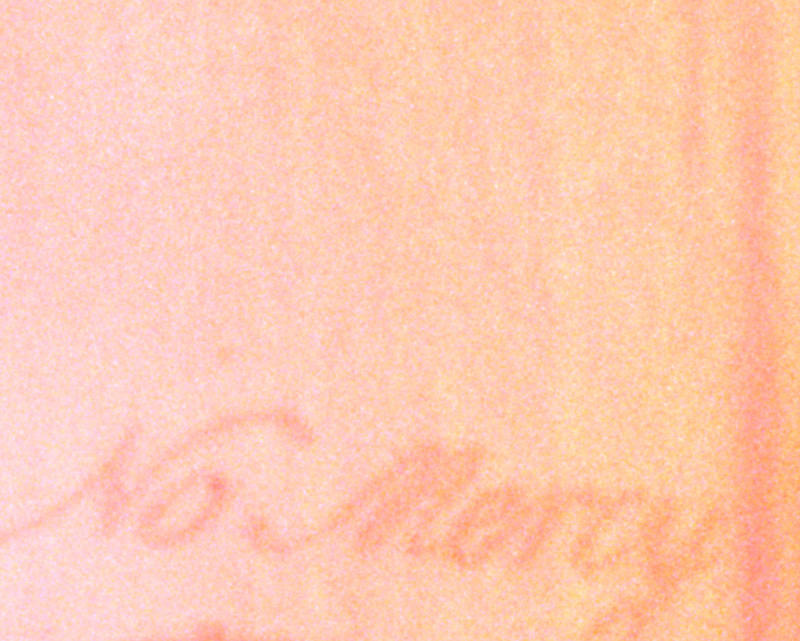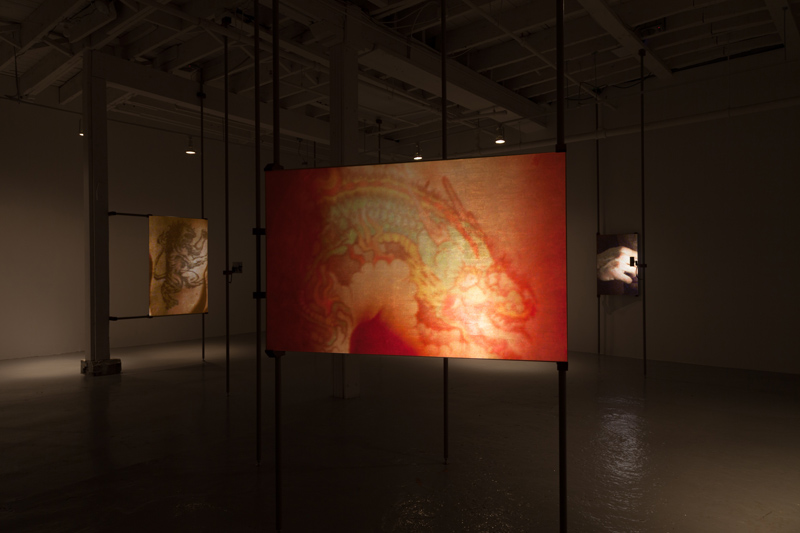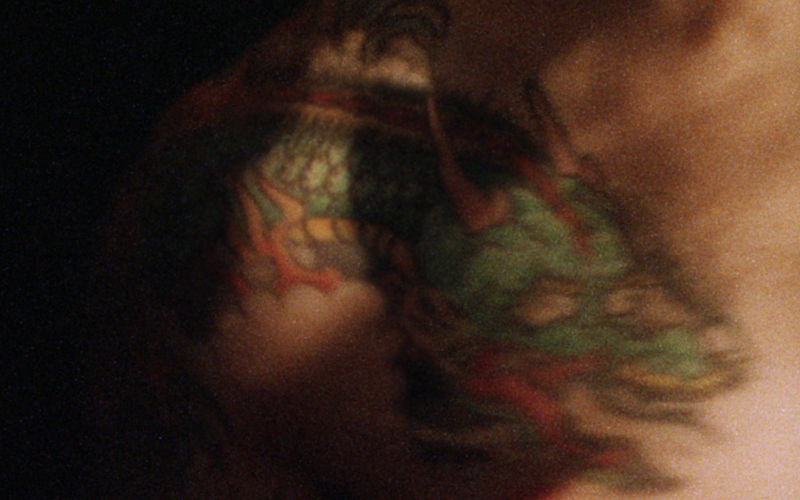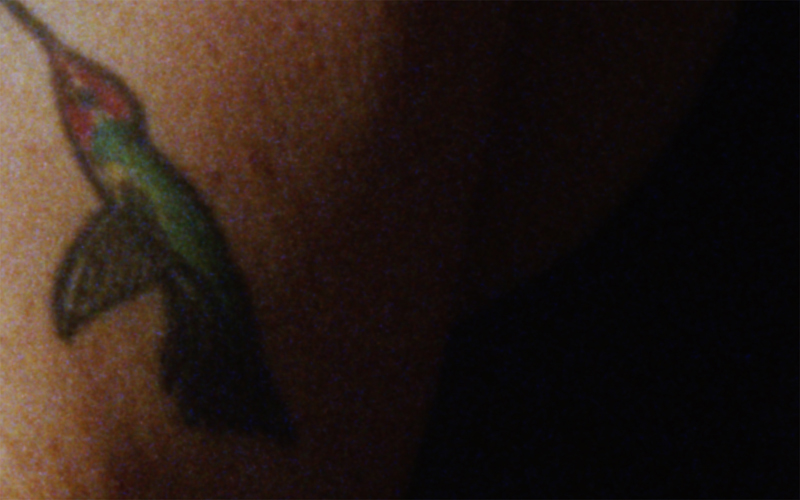Fraser Stables' Installation Cages Creatures

Fraser Stables assumes the roles of artist, collaborator and observer, using photography and video to explore themes of identity, masculinity, competition and performance. His interest in relationships amongst hierarchies and systems of representation result in unexpected connections among images that initially seem entirely disparate.
The Scottish-born Stables, now based in Northampton, Massachusetts, has exhibited his work in Canada, the United States, Japan and Europe. Magenta contributor Krystina Mierins met with Stables in Trinity Bellwoods Park on a sunny October day to discuss the installation work featured in his most recent exhibition, A Bestiary.

Krystina Mierins (KM): Walking into A Bestiary to find an installation of scaffold-like structures containing five projected videos was quite a surprise. I had been expecting photographs and screens mounted on walls.
Fraser Stables (FS): I have an interest in how images can be physically encountered. In these works, I was thinking of their relationship to the human body. It seemed appropriate to place them in space so the screens are hung at body height and they’re all within the body’s scale. They don’t present a prescribed sequence, but it’s important that there is potential for a spatial encounter by an audience.
KM: The five videos show tattoos of a lion, tiger, dragon, lizard and hummingbird on the bodies of fighters. How did the animals come to be a part of A Bestiary?
FS: I was interested in animals as totems and markers of identity, which relates to themes in past projects. In producing this installation, I filmed each fighter in a range of motion that was typical to their training or fighting, making sure that the animal stayed in the frame. In the editing process, I isolated the animal, scaled and animated each individual frame, and slowed down the footage. I worked to still the animal and present it as having a sort of plausibility, where one doesn’t think of the editing, but rather the animal has a sort of lingering existence within the frame. The animal’s motion is limited, but there are many moments of distortion and abstraction when the body angles away from the camera or there is motion blur from the fighter’s movement. Some of the videos show a slightly broader view in which the body is more present and there are moments that reveal the excluded material and space outside of the frame. Each video includes synchronized sounds of the fighter breathing, punching and moving, mixed with environmental sounds from the gym. Across the installation, the sounds match the movement of the animals but also introduce a sense of competing actions and environments.
KM: Why did you choose to show the videos on scaffold structures?
FS: I was thinking about these animals as specimens, and wanted them to hint at different systems of study, construction and presentation such as the science lab, museum display and provisional architecture. The painted metal poles are held together with walnut wood blocks that also support gold leaf screens. While the poles may allude to scaffold or even elements of a fighting cage, these wood connectors shift the framework and have a quality that is more delicate, domestic and furniture-like. I’m presenting the screens as objects that also are the spaces of the animals, and each animal becomes a specimen within the larger system.

KM: How did you choose to use gold leaf?
FS: I’m always thinking of the condition of the screen, the condition of presentation. I am interested in a screen affecting the image and viewing experience. In particular, I was thinking about how the pages of a medieval bestiary are highly decorative and adorned with gold leaf. I like that connection, but also gold in relation to a fighter’s belt or a trophy, and as something that has as much value in idea as it does in material. I also like the effect of the highly specular surface that impacts the brightness and colour of the image, producing a varied experience depending on the viewer’s angle to the screen.
KM: Is an audience necessary to complete your work?
FS: An audience is important to the work. To varying degrees, like many artists, I can become isolated within my own relationship with the work, but I also think about how it might be engaged physically, conceptually and historically, so the act of viewing is always a consideration.
KM: Some artists have told me they can’t think about their audience when they are making their work.
FS: There is a difference between the image content and the physical structure of the work. I have my own sets of relationships that I’m interested in because the work spans many subjects. It’s useful for me to think not just from my isolated position or my isolated connection to these subjects, but for me to speculate upon how these things exist as cultural objects within a broader semiotic landscape. An artist triangulates many things in the world and the thought of how a viewer might encounter a work physically or conceptually is one of the things that I as an artist find myself considering – not as a guiding factor but as an element within the work that is not insignificant.
I am interested in the viewer and this produced experience, but I do not want to construct an experience that is closed. I want there to be incidental ties, and that’s something that comes when you’re not trying to plan everything for an audience. I enjoy the intersection between planning and something that takes on a life of its own outside of a controlled path.
KM: You take on a role similar to that of an anthropologist, while also being artist, observer and collaborator. Is this a complex position to maintain?
FS: I think that’s well described. There are a lot of people who speak of the role of the artist as being that of the amateur, in the way that artists can make something that connects to different fields and practices, creating a hybrid lens upon the world. I enjoy occupying this role between disciplines in which I feel I can collaborate and shift between objective and subjective positions.

KM: In an artist’s statement (Core 2000, Glassell School of Art, Museum of Fine Arts, Houston, Texas), you wrote that you were interested in the separation between people and their surroundings. In many of your works, the constructed identities appear to be inseparable from the setting. As someone who does not engage in mixed martial arts fighting, how did you end up in this setting?
FS: The genesis for this work was in an earlier project I exhibited at Galerie IFF in France (No Mercy, 2009), for which I worked with the person who has the hummingbird tattoo. He’s a former boxer, whereas the other people are current mixed martial arts fighters. Above his hummingbird is the text “No Mercy.” When I saw these two tattoos in proximity, I thought it was a beautiful readymade where the hummingbird was feeding from the “No Mercy” script. I immediately wondered when they were produced and how they connected to him as a fighter who no longer fights. I imagine the script is from a time when he was a fighter and the bird from a time after, but that may be wrong. I made a video showing both tattoos. I used very slow-motion footage and cropped in on those two parts of the frame, but kept some surrounding details. I wanted there to be a sense that they were being seen during training, in preparation for a fight rather than in a fight. For me, that echoed the fragmentation that I saw in the relationship between the two tattoos. One of the problems was that I shot with video, and there was a lot of distortion because of the fast movement and technical limitations with video. I thought about film as a solution and I wanted to revisit the idea with that person, which led to this current body of work. I was also interested in the materiality of film becoming present as the frames were magnified, and the potential for this to give a sense of mediation and examination. At this point in time, film is also somewhat anachronistic, which is of interest given the connections I want to make between contemporary and historic imaging traditions. Following this, I did more shooting and I started to go to local gyms with the 16mm camera.
KM: How have subjects reacted?
FS: It has varied. There are a lot of traditions with photography and filmmaking where you work with human subjects and there are many people who go to gyms to photograph boxing. There are moments when I have to work out what my relationship is to these people, how to introduce myself and I enjoy those points of contact. These interactions can be problematic, difficult, stressful, but the nature of that social moment is of interest to me. In producing this, I went to one local gym that ended up being incredibly helpful: Ravenous MMA in Greenfield, Massachusetts. I spoke to Joe, the fighter with the lizard tattoo, and he was very receptive. He shoots at the MMA events himself, so has a connection with the moving image and immediately got the idea.
I was in Atlantic City working on a different project and I thought I should explore local gyms. In one instance, the negotiation didn’t go well and the Master threatened to bite my nose, so I got out immediately.
I’m engaging a world that I’m not part of. I’m not totally reconciled with what that means, but I am interested in the subject for a range of conceptual reasons. I am interested in the condition of representation, in this case what the animal imagery means in contemporary society, and how it may be coordinated with historic imagery and references, the condition of the human body, and the question of signification. But I don’t want to do a documentary project on the gym.
I am also interested in the social encounter produced around the search for these animals and these conditions. As I’ve been working, I’ve been shooting for the fighters at their fights so there is a trade that continues. I’m working for them at a certain level and I’ve always liked that trade, that social contract. It’s a large part of the work even though it’s not necessarily evident within the final work.
KM: I’m intrigued by this idea of a social contract. Has it had a strong role in any of your other projects?
FS: For a week I set up in Kingston, Pennsylvania at Paper Kite Gallery. They had an interest in community-related events and programming, and I proposed to do this project for them in which I’d offer free photographic services. During the week, I produced the images that people wanted. Partly, I was interested in what images people need taken for them at this point in time. We all have cell phones, we all have cameras. One doesn’t necessarily need the professional anymore. I was wondering why someone would come into a studio, although I think the formality is still important. So, I had people coming in with their kid and putting on a nice shirt, wanting an image to surprise their spouse. There were many families and individuals who wanted formal portraits, and I went to gatherings and a family reunion. That week was interesting in terms of how the social contract played out, and I found myself playing a role the entire time and reflecting on the instability of that role. I wondered what makes me a better photographer in any of these moments? What would make a better photograph? Is it what the subject wanted? And, at the same time, I also thought about how these subjects and portraits existed within my broader practice. I continually reflected on the range of implications and, at the same time, I was trying to do my best to produce the images they wanted.
KM: In your previous project Solo Shoot (2001–ongoing), Scott’s explanation of the tattoos was an important part of the work. Was it important for the fighters to share the stories of their tattoos?
FS: In a lot of my work, I’m interested in discrepancies, and I think that connects to my training in photography. You have a record of a fact, but it’s not the fact. The minute you have a separate photograph, you have the production of an artefact even though it has an intrinsic connection with the real, and with a past time. For the work with Scott, part of my interest in the tattoos was the discrepancy between his intentions for what he planned to have tattooed and what actually happened. It became important to reveal discrepancy, and, with a long-term project, it’s especially possible to explore that.
I don’t know if I could fully say why, but it wasn’t important for me to get into the personal narrative about why the fighters chose particular animals. I kept it at a far more general level. I suppose I was trying to capture the animal versus the person, so if there is too much back story the project becomes about that and I was trying to allow these animals to exist where the body became secondary, the fighter became secondary. When I say secondary, I do not meaning unimportant, but rather peripherally present.
KM: Do the video installations in the front gallery relate to the photographs in the back gallery?
FS: Neither is dependent on the other. The photographs are from several different projects, some of which are ongoing. I was trying to reflect on the relationship within the videos when sequencing the still image work. I was thinking of systems of representation, depictions of the natural world, and the relationship between different hierarchies or power structures.
In the front gallery, the tattoos and fighters are contemporary but they are being presented on gold leaf with reference to the medieval bestiary, so one might think of both museums and fighting venues. They reference things of a very different order and yet there is a seamless way in which the screens and the images come together. I think different relationships are present, but they are not disruptive. The relationships amongst the photographs are more disruptive. The first image shows a casino ceiling with painted clouds, but it has sprinkler heads and the shadows of wires on what appears to be a sky. On close examination, the sky reveals itself to be a simulation. Hung next to that is the image of Philip Johnson’s Glass House, in which the Poussin painting has clouds in the sky that are remarkably similar to the sky in the casino. From ten feet away, we recognize that the image in the Glass House is a painting, but not that the casino ceiling is also a reproduction. There is equivalence between the two, which disrupts the order of both sites.
A Bestiary was displayed at Georgia Scherman Projects in Toronto from September 12 to October 12, 2013.
Krystina Mierins completed her MA in Art History before working in the architecture department at the Carnegie Museum of Art. She has also worked at the Carleton University Art Gallery and the McMaster Museum of Art. She is now an independent writer based in Toronto, and her writing has appeared in publications such as Border Crossings, Artillery and Ornamentum.



